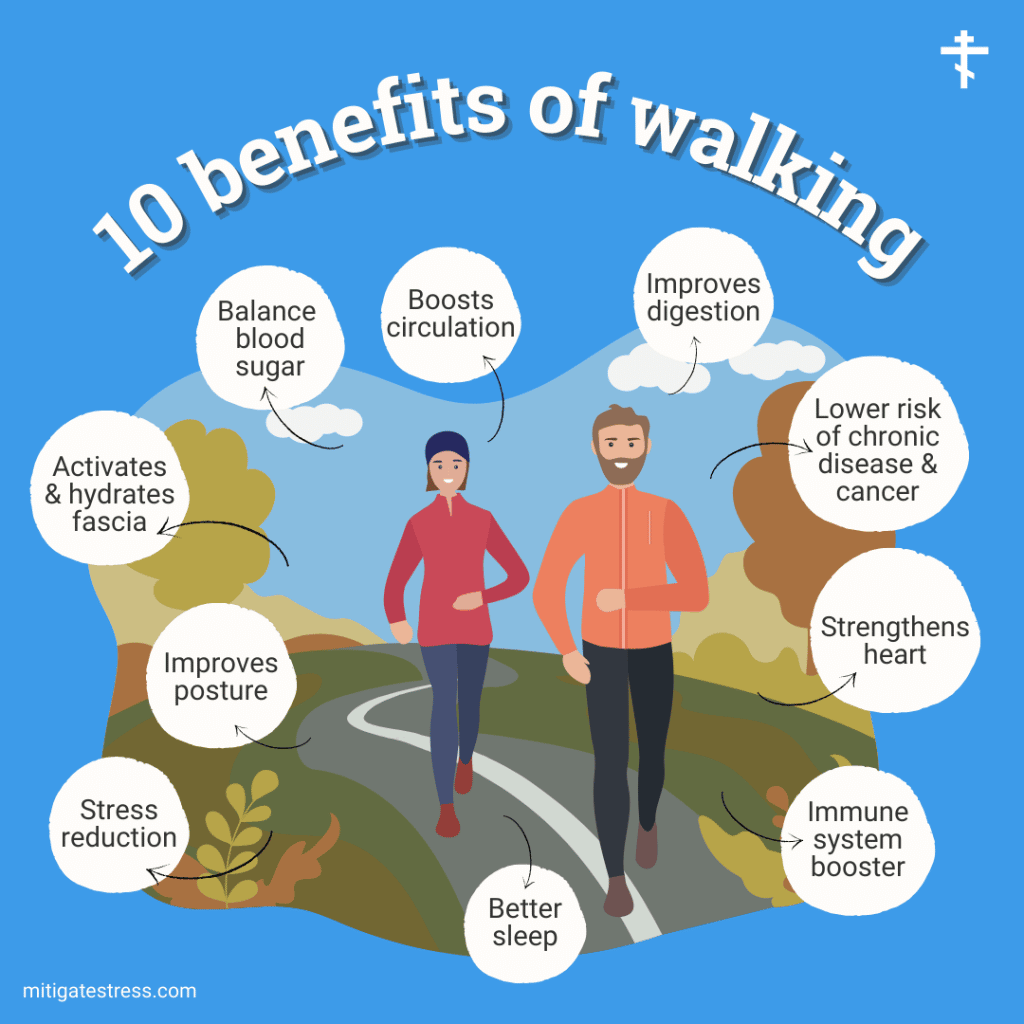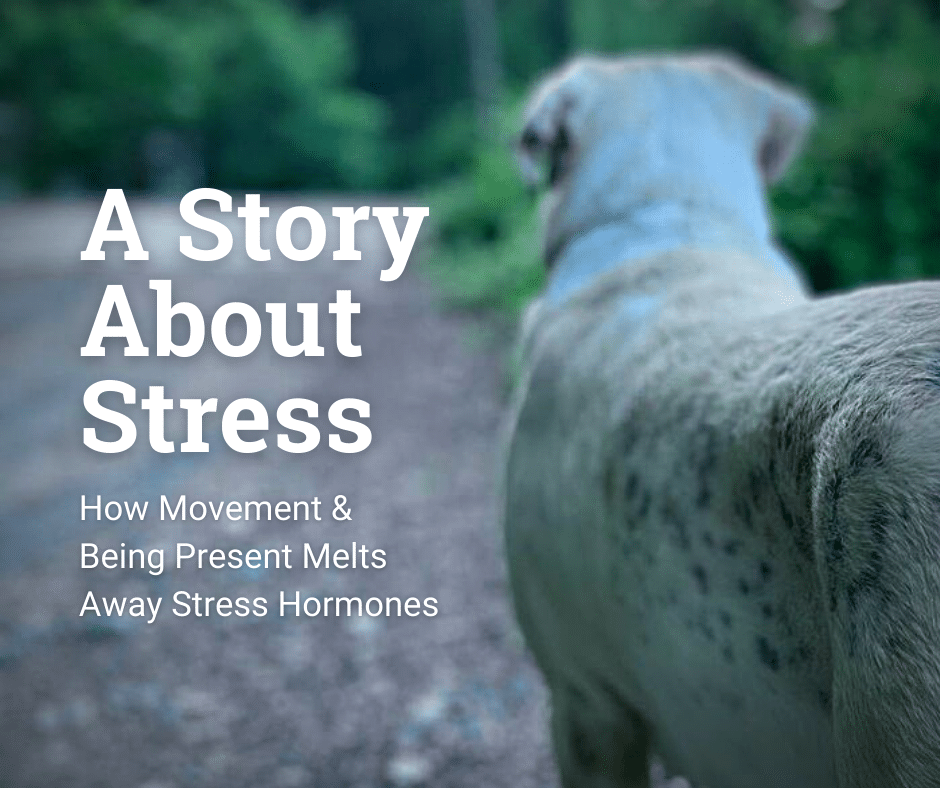Walking is one of the most underrated exercises of all time. It is often assumed that you need expensive gym equipment to stay fit and healthy. In reality, simply walking can be just as beneficial (if not more), enjoyable, and less stressful.
People of all ages and levels of fitness can benefit from a daily walk. As well as preventing certain diseases, it could even lengthen your life. The best part about walking is that it’s free and easy to fit into your daily routine.
Check out these walking benefits.
Boosts circulation to your brain
The foot’s impact during walking sends waves of pressure through the arteries, increasing blood supply to the brain, researchers at New Mexico Highlands University (NMHU) found. Cerebral blood flow was thought to be involuntary and regulated by the body. It was believed that the blood supply to the brain remained relatively unchanged despite changes in blood pressure during exercise. However, the team of researchers found that the foot impact triggers substantial backward-flowing waves through the arteries, synching up with the heart rate to regulate blood flow to the brain.
Better sleep
According to a recent Sleep Health study, walking generally leads to better sleep. Women slept better but not longer after walking, meaning their sleep quality improved, but their sleep duration didn’t.
Getting sunlight early in the morning helps entrain a strong circadian rhythm that promotes healthy sleep. Sleeping better may also be linked to exercising, reducing stress, and enhancing physical well-being. Taking a walk with another person could boost one’s mood, thereby improving sleep.
Improved digestion
If you have just eaten a heavy meal, a calm, soothing walk can do wonders for digestion. The abdominal muscles contract when you walk or exercise, pushing food and waste through your digestive tract. You will be able to keep your bowel movements regular just by walking. Walking will contract your belly muscles, push out gas, and keep you pooping regularly. You will experience less gas and bloating once you begin having regular bowel movements.
Improves posture
Each walk will stimulate your entire nervous system while providing long-term posture changes if performed correctly, which affect virtually every cell in the human body. Our fascia is like a sponge; in order to hydrate our body from head to toe, we must wring out this sponge on a daily basis. That is our goal. The most effective and efficient way to do so is to walk!
Your posture affects every aspect of your physiology; when you work on your posture in motion, also known as your gait mechanics (walking mechanics), this improves your performance and recovery in every athletic area. It’s the ultimate performance, hydration, healing, and recovery movement.
The key to walking properly is to be present. Not distracted by music, texting, Instagram, podcasts, talking, or walking your dog holding onto a leash. While leisurely walking is not bad in and of itself, this kind of walking often distracts us from our awareness of the subtle changes in gait, posture, and balance. We want awareness walking to benefit fully from our walks. This is the issue; people do not take walking seriously, nor do they stay consistent with it. We recommend you treat walking as a serious exercise with the same level of attention you would lifting weights or exercising at the gym. Also, if the only walks you can do are with your dog, know that this may pull you irregularly on one side, so we recommend switching the leash from each side, focusing on your gait and balance, or trying using a harness to attach the leash to your belt or chest.
Think of your body as a car. If your tires are misaligned, and you aren’t aware of that, eventually, your car will become degraded. The longer you drive it, the more the performance will suffer. Cornering, braking, and much more will suffer. Our bodies are similar. If we don’t treat walking like a serious exercise, paying attention to the queues of our body, then the misalignments may be missed, and the overall performance and power of our body will suffer.
A leisurely walk can relieve stress in the short term, just as smoking a cigarette does, but over time the body may experience even more stress. However, some movement is better than none at all. You just need to stay aware of your walking habits and stay present. It does not have to be stressful. It should be the opposite because you will be able to prevent long-term injuries, inflammation, and pain.
Don’t be afraid to move more. Walk, play, have fun, and dance. But you need to know that if you want to reap all the benefits of walking as an exercise, you need to allow the time to focus on it. Be aware of the limitations, pain, and discomforts of your body. Walking is a seriously effective movement that will change your body if you allow it and listen to it.
The more you walk, the better you will get at walking. It’s that simple. Combine it with deep trigger-point release therapy and corrective exercises from modalities such as Functional Patterns, MoveMed, and One-of-a-Kind Fitness, and you will experience even more efficient walking.
Posture is the essential focus for making these walks not only extremely effective but efficient with your time. When properly executed consistently, the ROI on these walks is exponential, with hundreds of health benefits. There are many cues, but the main focus is to perform a hinge hold corrective before every session, if possible, and apply a healthy amount of reciprocating (twist) movement in the T-Spine/Torso. The more you trigger-point and perform correctives, the better your walking will be.
Again, we aren’t discouraging you from walking. In fact, we encourage you to walk more because it is in your biological blueprint. However, merely telling you to walk isn’t enough. Begin by relaxing and examining your entire body (jaw, hands, eyes, face, abs, calves, etc.). Keep your shoulders and back from hunching over while you walk. Stand tall with a level chin, looking into the horizon, and get into a good rhythm and stride that allows you to open up and stretch the front of the hips while breathing deeply, but methodically. Focus on standing tall and taking long efficient strides without tensing up. Always remember to breathe and relax. With this position, your muscles are strengthened, improving your overall posture. Your pelvis, legs, abdomen/torso, as well as your extremities should experience massive blood flow and circulation as you move.
Take mental notes while you walk. (My calf felt mildly overworked on my left side more than my right, my right hip was jarring and felt it was jammed, my jaw was very tense on my left side, my hands were tight, my eyes were strained, etc.) We have to be aware of these things if we want to mitigate stress.
If your feet hurt after the walk, that gives you a clue that they are weak. Then you know to take a hot bath and/or trigger-point your feet/calves before and after each walk until they no longer are in pain or are sore. A walk is a diagnostic tool. It’s our bodies’ way of giving us feedback so we can attack it in the “lab”.
We’re not trying to climb Mount Everest. Just start with a few things at a time. When you feel yourself becoming too distracted, bring the awareness always, back to the walk.
Balances blood sugar
Walking after eating can lower your blood sugar, especially if you have type 2 diabetes.
Researchers found that taking a 15-minute walk three times a day (after breakfast, lunch, and dinner) significantly improved blood sugar levels compared to taking a 45-minute walk once a day.
A similar study found that walking after dinner lowers the glycemic reaction to dinner, compared with a pre-dinner workout, in people with type 2 diabetes.
A study by Scand J Prim Health Care measured blood glucose before and after walking and resting for 29 people with type 2 diabetes aged 63. Patients walked for half an hour on one occasion and remained physically inactive on another. During the post-walk period, glycemic levels decreased by 2.2 mmol/l (SD 1.5). However, physical rest had no significant effect on glucose levels. Walking in groups or individually can be a safe, effective means of introducing people with type 2 diabetes to low-intensity exercise and demonstrating its blood glucose-lowering effect.
Adding a post-meal walk to your routine can benefit most people.
Immune booster
You may be less likely to catch a cold or the flu if you walk.
During flu season, researchers tracked 1,000 adults. This study found that walking for 30 to 45 minutes a day at a moderate pace led to 43 percent fewer sick days and 96 percent fewer upper respiratory tract infections compared to sedentary adults who did not exercise. Also, a daily walking routine lessened their symptoms if they did get sick.
Several different types of immune cells are activated after 20-30 minutes of brisk walking or moderate-intensity cycling, according to a study in the Journal of Sport and Health Science. The exchange of specific components and cells of the innate immune system between lymphoid tissues and the blood compartment is stimulated by acute exercise. Over time, a summation effect occurs, with better immune surveillance against pathogens and cancer cells and less inflammation in the body. On the other hand, high exercise training workloads, competition events, and the resulting physiological, metabolic, and psychological stress increase illness risks, inflammatory symptoms, inflammation, oxidative stress, and muscle damage. These positive responses are thought to strengthen your immune system when you regularly walk at a low intensity.
Getting in a daily walk can help you reap these benefits. If the weather does not permit outdoor exercise, you may want to consider walking on a treadmill.
Stress reduction
The benefits of walking for your mental health are numerous. Research shows it reduces anxiety, depression, and negative mood. As well as boosting self-esteem, it can also reduce social withdrawal symptoms.
In addition to lowering blood pressure, exercising releases feel-good hormones (endorphins) that reduce stress hormones like cortisol. A 20-minute walk outside during daylight can provide a dose of vitamin D, which has been proven to ease depression symptoms. In addition, exercising outdoors lowers stress-induced cortisol levels more effectively than exercising indoors at the same intensity.
Walking with a friend increases its benefits. Taking a walk with friends can help you combat isolation, which can sometimes cause an increase in stress hormones.
Strengthens heart
The more you walk, the more you work your muscles and heart. As a result, your heart pumps more blood, keeping it healthy and strong and keeping your blood vessels flexible. Walking decreases other risk factors for heart disease as well.
At the Lawrence Berkeley National Laboratory, Life Science Division in Berkeley, California, researchers found that running and walking reduced three heart disease risk factors – high blood pressure, high cholesterol, and diabetes – similarly over a six-year period.
In 2002, nearly 74,000 postmenopausal women participated in a study led by researchers from Harvard Medical School that provided even more compelling evidence. There was no heart disease among the women at first, but after about three years, those who walked briskly or did vigorous exercise for at least two and a half hours a week were 30 percent less likely to get heart disease.
In a recent study, researchers at Binghamton University’s Decker School of Nursing looked at 70 women from ages 29 to 79 who took part in a community walking program. For 10 weeks, the researchers had the women wear pedometers during their waking hours and walk briskly for 150 minutes. They improved their systolic blood pressure (top number), weight, and body mass index, which are all risk factors for heart disease. Another test, a 6-minute walk, showed better results for the women. Researchers found moderately intensive walking improved cardiovascular risk factors even in the short term.
Lower risk of chronic disease and cancer
Studies have linked walking with lower risks of breast cancer, colon cancer, heart disease, kidney disease, and diabetes.
Researchers already know that physical activity reduces the risk of breast cancer. It also reduces the risk of developing breast cancer. In a study by the American Cancer Society, women who walked seven or more hours a week had a 14% lower risk of developing breast cancer than women who walked three or fewer hours. Women with breast cancer risk factors, such as being overweight or hormone use, were also protected by walking.
A little exercise every week can reduce your risk of colon cancer by 30 to 40 percent, according to studies cited by the National Cancer Institute. Furthermore, exercise has been shown to be beneficial for patients with cancer that has spread. Exercise can even be helpful after colorectal cancer surgery. The American Cancer Society says people who exercise regularly after having been treated for colorectal cancer will be less likely to die from it later. After colorectal surgery, exercise has been linked to a better quality of life and reduced fatigue. Before starting an exercise routine after colorectal surgery, speak with your doctor.
Pre-dialysis chronic kidney disease patients may also benefit from walking. A prospective study compared the benefits of regular walking for six months in 40 patients with Stage 4 and 5 chronic kidney disease. Twenty patients underwent exercise, while 20 patients underwent normal physical activity. Improvements noted after one month were sustained to 6 months in the 18 of 20 who completed the exercise study. Among these improvements were improved exercise tolerance (less exertion to accomplish the same actions), weight loss, improved cardiovascular reactivity, avoiding a dose increase of blood pressure medication, and improvements in health and well-being, as well as uraemic symptom scores.
A Taiwanese study in the Clinical Journal of the American Society of Nephrology found that patients with kidney disease who exercise regularly live longer and are less likely to require dialysis or a transplant. More than 6,300 averaging around 70 years old Taiwanese people with chronic kidney disease (CKD), were tracked by his team. The patients were followed for an average of 1.3 years, and about 21 percent of them called walking their most common form of exercise. Walking reduced mortality risk by a third during the study time frame, and compared to patients who did not walk, they were 21 percent less likely to require dialysis or a kidney transplant.
Patients who walked more received more significant benefits. According to the researchers, people who walked at least two times a week, three times a week, five times a week, and seven times or more a week were 17 percent, 28 percent, 58 percent, and 59 percent less likely to die, respectively. Additionally, they were 19 percent, 27 percent, 43 percent, and 44 percent less likely to require dialysis or kidney transplants.
Activates and hydrates fascia
Each walk will create more activation and hydration among your entire fascial system.
As a connective tissue, fascia is found in every part of our body. Fibers (collagen) require a substance known as Glycosaminoglycans (GAGs) to bond together. GAGs are mucopolysaccharides, which are just long words for snot. Basically, we are held together by mucous. By essentially ringing out our fascia like a rag, movement hydrates our fascia. Each rotational movement brings more hydration to the tissue. After that, the lymphatic and vascular systems carry wastes to the liver, and the blood supplies new fluids to the tissues. Walking helps to “wring out” and hydrate our fascia and assists the lymphatic system flow throughout the body, removing waste.

Conclusion
We hope that you have found this information useful. Walking is an ideal activity for anyone who wishes to maintain a healthy lifestyle. It’s free, easy, and can be done without special equipment.
Walking 10-20 minutes 3x a day speeds up the metabolism, aids digestion, provides space and circulation, lowers stress responses, and is excellent for weight loss compared to its cardio cousin (excessive amounts of endurance cardio). When we provide awareness, cueing, posture, and prep work, walking becomes a consistent postural habit that will create permanent results.
It’s Walking with Awareness, Intention & Correction. It’s Conscious Walking.
Before beginning an exercise program, talk to your health practitioner first.
Make your walk even better with barefoot shoes. They have thin and flexible soles that adjust to the shape of the human foot, making them ideal for walking, running, and athletic activities. Check out these brands we use and love.
Resources:
- How walking benefits the brain – ScienceDaily. https://www.sciencedaily.com/releases/2017/04/170424141340.htm
- Walking increases blood circulation to the brain – Bel Marra Health. https://www.belmarrahealth.com/walking-increases-blood-circulation-brain/
- Want to Sleep Better? Go for a Walk | Psychology Today. https://www.psychologytoday.com/us/blog/think-act-be/201910/want-sleep-better-go-walk
- Walk to a better night of sleep: testing the relationship between physical activity and sleep | Sleep Health https://www.sleephealthjournal.org/article/S2352-7218(19)30105-6/fulltext
- Walking for Digestion https://www.wellandgood.com/walking-for-digestion/
- Loretta DiPietro, Andrei Gribok, Michelle S. Stevens, Larry F. Hamm, William Rumpler; Three 15-min Bouts of Moderate Postmeal Walking Significantly Improves 24-h Glycemic Control in Older People at Risk for Impaired Glucose Tolerance. Diabetes Care 1 October 2013; 36 (10): 3262–3268. https://doi.org/10.2337/dc13-0084
- Colberg, Sheri R et al. “Postprandial walking is better for lowering the glycemic effect of dinner than pre-dinner exercise in type 2 diabetic individuals.” Journal of the American Medical Directors Association vol. 10,6 (2009): 394-7. doi:10.1016/j.jamda.2009.03.015
- Fritz, T, and U Rosenqvist. “Walking for exercise – immediate effect on blood glucose levels in type 2 diabetes.” Scandinavian journal of primary health care vol. 19,1 (2001): 31-3.
- Upper respiratory tract infection is reduced in physically fit and …. https://bjsm.bmj.com/content/45/12/987
- Nieman, David C, and Laurel M Wentz. “The compelling link between physical activity and the body’s defense system.” Journal of sport and health science vol. 8,3 (2019): 201-217. doi:10.1016/j.jshs.2018.09.009
- Nieman DC, Wentz LM. The compelling link between physical activity and the body’s defense system. J Sport Health Sci. 2019 May;8(3):201-217. DOI: 10.1016/j.jshs.2018.09.009. Epub 2018 Nov 16. PMID: 31193280; PMCID: PMC6523821.
- Sharma A, Madaan V, Petty FD. Exercise for mental health. Prim Care Companion J Clin Psychiatry. 2006;8(2):106. DOI: 10.4088/PCC.v08n0208a. PMID: 16862239; PMCID: PMC1470658.
- Olafsdottir, Gunnthora, et al. “Health Benefits of Walking in Nature: A Randomized Controlled Study Under Conditions of Real-Life Stress.” Environment and Behavior, vol. 52, no. 3, Apr. 2020, pp. 248–274, doi:10.1177/0013916518800798.
- Walking for exercise and stress reduction – Atlanta | Johns Creek …. https://johnscreekfamilypractice.com/walking-for-exercise-and-stress-reduction/
- Can Walking Really Help Your Heart? – Andrew Weil, M.D. – DrWeil.com. https://www.drweil.com/health-wellness/body-mind-spirit/heart/can-walking-really-help-your-heart/
- Paul T. Williams and Paul D. Thompson, “Walking Versus Running for Hypertension, Cholesterol, and Diabetes Mellitus Risk Reduction.” Arteriosclerosis, Thrombosis, and Vascular Biology, April 4, 2013, doi.org/10.1161/ATVBAHA.112.300878
- Pamela Stewart Fahs et al., “Walking for Heart Health: A Study of Adult Women in Rural New York.” Creative Nursing, November 1, 2016 DOI: 10.1891/1078-4535.22.4.268
- Harvard Health Publishing. “5 Surprising Benefits of Walking – Harvard Health.” Harvard Health, Harvard Health, 2019, www.health.harvard.edu/staying-healthy/5-surprising-benefits-of-walking.
- National Cancer Institute. “Physical Activity and Cancer.” National Cancer Institute, Cancer.gov, 10 Feb. 2020, www.cancer.gov/about-cancer/causes-prevention/risk/obesity/physical-activity-fact-sheet.
- Cancer.org, American Cancer Society, 2015, www.cancer.org/cancer/colon-rectal-cancer/after-treatment/living.html.
- Kosmadakis, G. C., et al. “Benefits of Regular Walking Exercise in Advanced Pre-Dialysis Chronic Kidney Disease.” Nephrology Dialysis Transplantation, vol. 27, no. 3, 27 July 2011, pp. 997–1004, 10.1093/ndt/gfr364. Accessed 7 May 2021.
- “Walking Could Be Key Step against Kidney Disease.” WebMD, www.webmd.com/kidney-stones/news/20140515/walking-could-be-key-step-against-kidney-disease. Accessed 8 Sept. 2022.
- “Walking Speed – a Predictor of Longevity.” Evidence-Based Fitness Academy, 1 Mar. 2021, ebfaglobal.com/walking-speed-a-predictor-of-longevity/. Accessed 8 Sept. 2022.
- Meyers, Thomas. “Fascial Matrix Hydration – Q & a with Tom Myers.” Anatomy Trains, 24 July 2017, www.anatomytrains.com/blog/2017/07/24/q-tom-hydration-fascial-matrix/. Accessed 8 Sept. 2022.






0 Comments